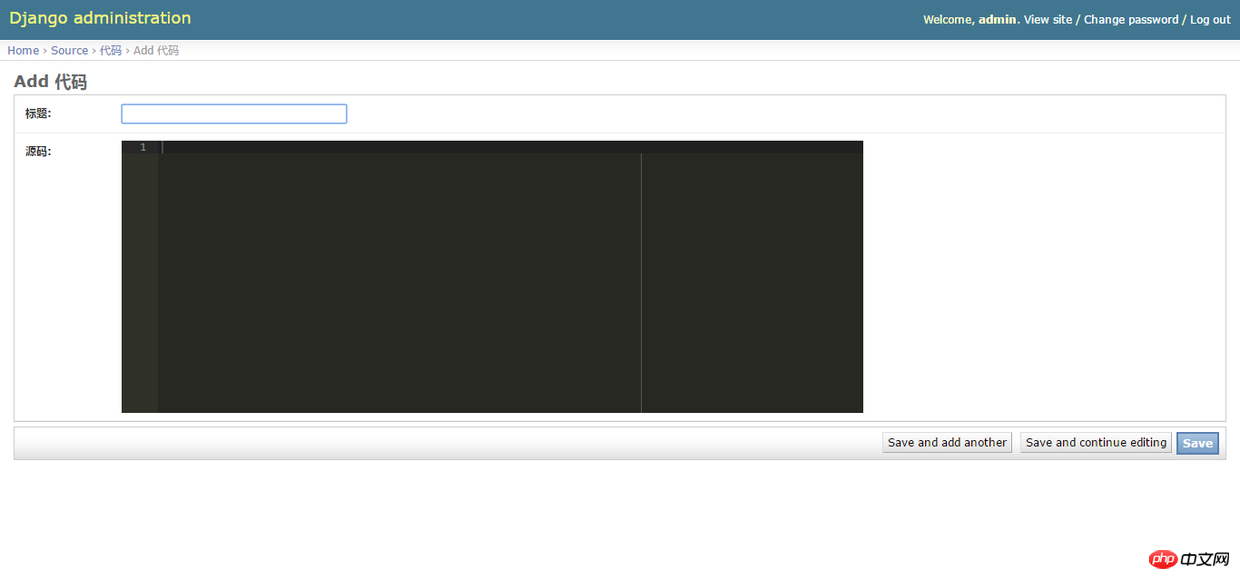
This article mainly introduces Django background custom form controls in Python. In fact, django has provided us with some available form controls, such as multi-select boxes, radio buttons, etc. If you are interested, you can learn more about it.
In django we can add ModelAdmin in admin.py , so that we can easily add, delete, modify and check in the background. However, the form generated corresponding to Model is not friendly. We hope to make various types of controls like front-end development, so we have to customize the backend form.
In fact, django has provided us with some available form controls, such as: multi-select boxes, radio buttons, etc. Let’s take the radio button as an example:
# forms.py
from django import forms
from .models import MyModel
class MyForm(forms.ModelForm):
xxx = forms.ChoiceField(choices=[...], widget=forms.RadioSelect())
class Meta:
model = MyModel
fields = ['id', 'xxx']
# admin.py
from django.contrib import admin
from .models import MyModel
from .forms import MyForm
class MyAdmin(admin.ModelAdmin):
form = MyForm
# ...省略若干代码
admin.site.register(MyModel, MyAdmin)Customize one first MyForm, add controls for fields in it, widget is used to specify the type of control, choices specifies the optional list, and then MyAdmin The form in can be designated as a custom form.
Django has provided a lot of widgets (controls), but these are far from meeting our needs, which requires us to customize them. Here is an ACE plug-in (ACE is an independent JavaScript (Web-based code editor written) as an example, let’s talk about how to customize the widget:
#coding: utf-8
from django import forms
from django.utils.html import format_html
from django.forms.utils import flatatt
from django.utils.encoding import force_text
from django.utils.safestring import mark_safe
ACE_RENDER = '''
<script src="/static/js/jquery-1.11.2.min.js"></script>
<script src="/static/js/ace/ace.js"></script>
<script>
$(function () {
var textarea = $('textarea');
var editp = $('<p>', {
position: 'absolute',
width: textarea.width(),
height: textarea.height(),
'class': textarea.attr('class')
}).insertBefore(textarea);
textarea.css('display', 'none');
var editor = ace.edit(editp[0]);
editor.getSession().setValue(textarea.val());
editor.getSession().setMode("ace/mode/%s");
editor.setTheme("ace/theme/%s");
textarea.closest('form').submit(function () {
textarea.val(editor.getSession().getValue());
});
});
</script>
'''
class AceWidget(forms.Textarea):
def __init__(self, mode="", theme="", attrs=None):
'''
为了能在调用的时候自定义代码类型和样式
:param mode:
:param theme:
:param attrs:
:return:
'''
super(AceWidget, self).__init__(attrs)
self.mode = mode
self.theme = theme
def render(self, name, value, attrs=None):
'''
关键方法
:param name:
:param value:
:param attrs:
:return:
'''
if value is None:
value = ''
final_attrs = self.build_attrs(attrs, name=name)
output = [format_html('<textarea{}>\r\n{}</textarea>', flatatt(final_attrs), force_text(value))]
current_ace_render = ACE_RENDER %(self.mode, self.theme)
output.append(current_ace_render)
return mark_safe('\n'.join(output))The main thing is that the customized widget should inherit from the django widget, and then rewrite the render method. In this method, Wrap the new control.
Introduce the custom control AceWidget in forms.py:
#coding: utf-8
from django import forms
from .models import Code
from widgets import AceWidget
class CodeForm(forms.ModelForm):
code = forms.CharField(label='源码', widget=AceWidget(attrs={'cols': '100', 'rows': '20'}, mode="python", theme="monokai"))
class Meta:
model = Code
fields = ['title', 'code'] It should be noted that: the used here mode="python", theme="monokai" The corresponding files mode-python.js and theme-monokai.js must be in /static/js /ace directory.
Rendering

Appendix:
models.py:
#coding:utf-8
from django.db import models
class Code(models.Model):
title = models.CharField('标题', max_length=50, unique=True)
code = models.TextField('源码')
class Meta:
db_table = 'code'
verbose_name = verbose_name_plural = '代码'
def __unicode__(self):
return self.titleadmin.py:
from django.contrib import admin from .models import Code from .forms import CodeForm class CodeAdmin(admin.ModelAdmin): form = CodeForm list_display = ['id', 'title'] admin.site.register(Code, CodeAdmin)
The above is the detailed content of Detailed example of Django background custom form control in Python. For more information, please follow other related articles on the PHP Chinese website!
 What is the use of docker image?
What is the use of docker image?
 How to find the location of a lost Huawei phone
How to find the location of a lost Huawei phone
 Clean the registry
Clean the registry
 How to set offline status on Douyin
How to set offline status on Douyin
 Oracle view table operation history
Oracle view table operation history
 Introduction to carriage return and line feed characters in java
Introduction to carriage return and line feed characters in java
 parseint function usage
parseint function usage
 What should I do if the docker container cannot access the external network?
What should I do if the docker container cannot access the external network?




